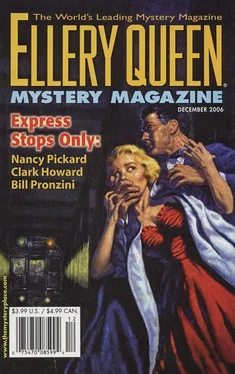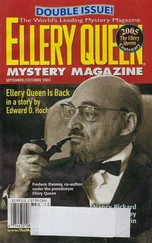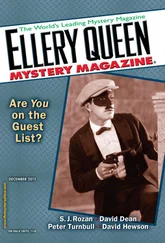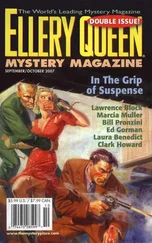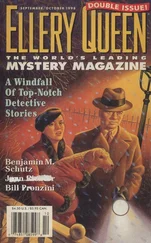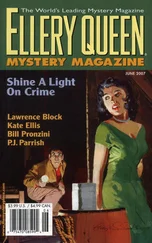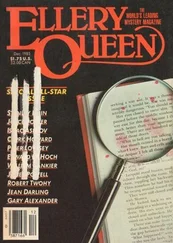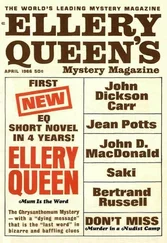Нэнси Пикард - Ellery Queen’s Mystery Magazine. Vol. 128, No. 6. Whole No. 784, December 2006
Здесь есть возможность читать онлайн «Нэнси Пикард - Ellery Queen’s Mystery Magazine. Vol. 128, No. 6. Whole No. 784, December 2006» весь текст электронной книги совершенно бесплатно (целиком полную версию без сокращений). В некоторых случаях можно слушать аудио, скачать через торрент в формате fb2 и присутствует краткое содержание. Город: New York, Год выпуска: 2006, ISBN: 2006, Издательство: Dell Magazines, Жанр: Детектив, на английском языке. Описание произведения, (предисловие) а так же отзывы посетителей доступны на портале библиотеки ЛибКат.
- Название:Ellery Queen’s Mystery Magazine. Vol. 128, No. 6. Whole No. 784, December 2006
- Автор:
- Издательство:Dell Magazines
- Жанр:
- Год:2006
- Город:New York
- ISBN:0013-6328
- Рейтинг книги:3 / 5. Голосов: 1
-
Избранное:Добавить в избранное
- Отзывы:
-
Ваша оценка:
- 60
- 1
- 2
- 3
- 4
- 5
Ellery Queen’s Mystery Magazine. Vol. 128, No. 6. Whole No. 784, December 2006: краткое содержание, описание и аннотация
Предлагаем к чтению аннотацию, описание, краткое содержание или предисловие (зависит от того, что написал сам автор книги «Ellery Queen’s Mystery Magazine. Vol. 128, No. 6. Whole No. 784, December 2006»). Если вы не нашли необходимую информацию о книге — напишите в комментариях, мы постараемся отыскать её.
Ellery Queen’s Mystery Magazine. Vol. 128, No. 6. Whole No. 784, December 2006 — читать онлайн бесплатно полную книгу (весь текст) целиком
Ниже представлен текст книги, разбитый по страницам. Система сохранения места последней прочитанной страницы, позволяет с удобством читать онлайн бесплатно книгу «Ellery Queen’s Mystery Magazine. Vol. 128, No. 6. Whole No. 784, December 2006», без необходимости каждый раз заново искать на чём Вы остановились. Поставьте закладку, и сможете в любой момент перейти на страницу, на которой закончили чтение.
Интервал:
Закладка:
So I’m sure you know just how I felt on that ledge—
Why I kept a safe distance away from the edge
As you leaned out so far to admire the view.
If the tables were turned, dear — now what would you do?
Copyright © 2006 Buzz Mauro
The Copyist
by Paul Lascaux, Stefan Slupetzky, Anke Gebert, Richard Lifka, Thomas Przybilka, & Christoph Spielberg
The idea for the following tale originated with Thomas Przybilka, head of the prize jury for the German Crime Writer’s Association. Asked to contribute a tale to a crime calendar, he proposed a “relay” story, in which each member of the prize jury (all notable fiction writers) would write a scene and pass the baton to the next member. Paul Lascaux led with a flexible scenario involving a Renoir painting, which allowed those who followed creative scope.
The sign on the front of the otherwise unprepossessing residence in a suburb of Grechtenweil boasted gold letters on black enamel and spelled out Winfred Kaltendorf. And under the name stood: Painter, Portraitist,Copier. The order ought to have been backwards, of course, when viewed from the standpoint of the activity that brought in Kaltendorf’s meager income. Indeed, a new commission had just arrived. The Grechtenweil Boating Club wanted a copy of Auguste Renoir’s Oarsman’s Breakfast for its clubhouse. Two thousand euros. To be delivered in one month, in time for the club’s anniversary celebration.
Winfred sighed gustily, startling the gray-and-white cat on the window sill out of her afternoon nap. The fee would cover the rent on his little house and the canvas and painting supplies he needed, but the few cents left over for liquor after he had paid the grocery bill scarcely rewarded the work of copying the Renoir. And besides: What did the boating club want with a copy when it could have a genuine Kaltendorf? Winfred longed to show the world that his own skills were every bit the equal of the great masters. He was only willing to concede a point or two on the issue of originality. And on the fact that he would never enjoy a place in the annals of art history; that much was clear.
He had already painted the entire background of the Oarsman. Only the painting’s figures and their heads were missing. Winfred bent over the local paper — or, to be more precise, over the page with the death notices. He had never had any patience with the sanctimonious sayings usually found there: “called to his last rest”; “torn abruptly from life.” Kicked the bucket; bit the dust; pushing up daisies; shuffled off this mortal coil: That’s the way Kaltendorf would have written death notices. And then that expressionless black-and-white photo of Mareike Koller, whose face Winfred was now painting carefully under the brim of the straw hat of the young woman leaning casually on the railing in the back of Oarsman’s Breakfast. The shadow cast by the hat was a blessing; it hid her lifeless eyes. Kaltendorf hadn’t had a chance to shoot his own photo of Mareike after the young woman came racing around the blind curve and steered her car over the cliff. He’d barely had time to get the warning signs that he’d used to block off the road stowed safely away in the trunk of his car before the sirens were audible. Someone in that nearby house must have noticed the accident. Faster, at any rate, than Mareike had noticed what she’d done when her car ruthlessly swept his favorite cat from the street. It was a stiff, inanimate face that stared up at him from the painting. Kaltendorf had to admit that this was not yet his masterpiece.
It’s a funny thing about art. The dramatist Johann Nestroy once said, “It’s only art when you can’t do it yourself. Because if you can, there’s nothing magical about it.” Well now, Winfred Kaltendorf could wield a paintbrush with the best of them — at least purely from the point of view of technique. But solid technique alone doesn’t make a genius, as he had been forced to admit to himself in his sorrowful but thankfully rare moments of self-understanding. His pictures just didn’t breathe, they didn’t live; they were missing a certain quality that separates the painter-for-a-living from the artist who is truly called to greatness.
Now, however, he had found it. The element that had been missing from his vocation, the salt in the bread of his creative prowess. He was sure of it... With a lightly furrowed brow he bent over and studied the portly man in the photo he had wedged into the lower corner of the easel. It was a good photo this time, even if it was a bit underexposed. Just like the mind of the man it depicted, thought Winfred, and smiled maliciously, in spite of himself. The photo showed Erich Pollack, owner of a small gallery in downtown Grechtenweil. An arrogant philistine who couldn’t distinguish a Rembrandt from a dirty spot on the wallpaper. “My dear Mr. Kaltendorf,” he’d said to Winfred when the latter had showed him his work, “You’re not exactly Van Gogh, are you now...?”
Kaltendorf began to copy Pollack’s face onto the canvas with painstaking attention to detail. He placed it on the body of a young man who was bending over a girl in the right side of the picture. “Perfect,” he purred to himself, comparing his work with the photograph. “Just perfect. And nobody can see that his ear’s been cut off...” There comes a time, you see, when a man just has to defend his honor. Such as when he’s compared with a lunatic Dutchman. The photo didn’t reveal how much more had been severed from the head than just the right ear — namely, the entire body. But that had no meaning at all from the spatial-conceptual point of view: Pollack’s “mortal coil” fit masterfully in Renoir’s composition.
Maybe Nestroy hadn’t been right, after all. Winfred’s mother had always said that art came from skill. As Winfred painted the portrait of the girl sitting at the table on the right side of the picture, he was suddenly very sure that his mother (God rest her soul) had been right, as she always was. Because he was painting as he’d never painted before!
It was Amelie’s face that came to life on the girl, looking up so expectantly at the man who was now wearing Pollack’s visage. And for this portrait, for the first time in his life, he didn’t need a photo or a drawing, not even the real Amelie as a model. Like a great pianist, who only needs to hear a melody once to be able to play it from memory, even to rearrange it or improvise on it, Winfred now made Amelie beautiful — more beautiful, perhaps, than she had really been. He regretted that he only had room for her face and her slim throat. He would have liked to immortalize her shoulders, her breasts, her thighs, and the dark triangle above them. He closed his eyes, remembering every detail. But the template forced upon him by Oarsman’s Breakfast did not allow him more. He painted like a man possessed. And isn’t possession one of the signs of a true artist? Winfred closed his eyes and saw Amelie, and then opened them and painted Amelie.
She had been his model. But not just a model, like all her predecessors. No, she was supposed to be more than that. His muse, at the very least. But now she was dead. And Winfred was creating her memorial. Painting like crazy, just the way he’d done when Amelie sat in his studio, naked and provocative. He’d studied her, painted, studied her again. He’d wanted to touch her, had used every opportunity at his disposal, arranging her in poses, composing her, you could say, his hands on her as often as possible. Amelie had let it happen and had laughed her carefree laugh. Until the day when Kaltendorf took hold of her and didn’t let go. And then Amelie abruptly pushed him away. And said things like “old” and “fat.” And asked him what made him imagine... And laughed, a dirty laugh that Winfred had never heard from her before. Well, that was it for Winfred Kaltendorf! And for Amelie. After all, she was only a college student; whatever had made her think...? He could have had any of the models he’d had before her, all of them, if he’d wanted them. But Winfred had desired only Amelie, and she hadn’t had the sense to appreciate it. “The most despicable women are the ones who lure a man and then push him away,” his mother had said once, and she’d been right, she always was.
Читать дальшеИнтервал:
Закладка:
Похожие книги на «Ellery Queen’s Mystery Magazine. Vol. 128, No. 6. Whole No. 784, December 2006»
Представляем Вашему вниманию похожие книги на «Ellery Queen’s Mystery Magazine. Vol. 128, No. 6. Whole No. 784, December 2006» списком для выбора. Мы отобрали схожую по названию и смыслу литературу в надежде предоставить читателям больше вариантов отыскать новые, интересные, ещё непрочитанные произведения.
Обсуждение, отзывы о книге «Ellery Queen’s Mystery Magazine. Vol. 128, No. 6. Whole No. 784, December 2006» и просто собственные мнения читателей. Оставьте ваши комментарии, напишите, что Вы думаете о произведении, его смысле или главных героях. Укажите что конкретно понравилось, а что нет, и почему Вы так считаете.
